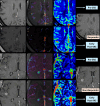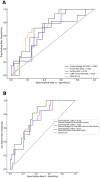Predictive value of early DCE and DSC perfusion MRI parameters for midterm clinical outcomes in lung cancer brain metastases treated with stereotactic radiosurgery
- PMID: 40408063
- PMCID: PMC12198322
- DOI: 10.1007/s11060-025-05054-5
Predictive value of early DCE and DSC perfusion MRI parameters for midterm clinical outcomes in lung cancer brain metastases treated with stereotactic radiosurgery
Abstract
Purpose: Stereotactic Radiosurgery (SRS) is an effective way of controlling the brain metastasis (BM) of lung carcinoma. This study evaluates the performance of dynamic contrast-enhanced MRI (DCE-MRI) and dynamic susceptibility contrast MRI (DSC-MRI) parameters to distinguish responders from non-responders at midterm follow-up in lung carcinoma BMs.
Methods: Twenty-six patients (mean age 62 ± 10 years) with 54 lung carcinoma BMs (NSCLC 67%, SCLC 33%) underwent SRS. The DCE-MRI and DSC-MRI were performed at baseline and repeated 4-8 weeks post-SRS to predict treatment responses at the midterm follow-up (6-12 months). Midterm outcomes were classified according to RANO-BM criteria as responders (complete response, partial response, or stable disease) or non-responders (progressive disease). Receiver operating characteristic (ROC) analyses evaluated the diagnostic accuracy of individual perfusion parameters and their combinations.
Results: Forty lesions (74%) were responders, while 14 (26%) were non-responders. Progressive lesions showed a mean volume increase of 5.5-fold, whereas responders demonstrated a 60% mean volume reduction. Responders showed significantly lower absolute post-SRS K-trans (median 0.015 vs. 0.035 min⁻¹; p = 0.005), a higher proportional decrease in K-trans from baseline (- 27% vs. +13%; p = 0.017), and lower post-SRS Ve (p = 0.009) compared to non-responders. Absolute post-SRS K-trans had the highest individual predictive accuracy (AUC = 0.75, accuracy = 78%, sensitivity = 86%, specificity = 55%). Neither the dynamic change nor post-SRS nCBV alone predicted midterm response; however, combining post-SRS nCBV with K-trans slightly improved predictive performance (AUC = 0.76, accuracy = 79%).
Conclusion: Early post-SRS absolute K-trans is the best perfusion parameter for predicting midterm response in lung carcinoma BMs. DSC-MRI parameters alone offer limited predictive value.
Keywords: Brain metastasis; Lung carcinoma; Perfusion MRI; Stereotactic radiosurgery.
© 2025. The Author(s).
Conflict of interest statement
Declarations. Ethical approval: This study was performed in line with the principles of the Declaration of Helsinki. Approval was granted by the Non-interventional Clinical Research Ethics Committee of Koc University under reference 2025.100.IRB2.047. Informed consent: Signed informed consent was waived from all individual participants included in the study. Competing interests: The authors declare no competing interests.
Figures





Similar articles
-
Differentiation of tumor progression from pseudoprogression in glioblastoma patients with GRASP DCE-MRI and DSC-MRI.J Neuroradiol. 2025 Jun;52(4):101354. doi: 10.1016/j.neurad.2025.101354. Epub 2025 May 24. J Neuroradiol. 2025. PMID: 40419180
-
Magnetic resonance perfusion for differentiating low-grade from high-grade gliomas at first presentation.Cochrane Database Syst Rev. 2018 Jan 22;1(1):CD011551. doi: 10.1002/14651858.CD011551.pub2. Cochrane Database Syst Rev. 2018. PMID: 29357120 Free PMC article.
-
Single and multitarget stereotactic radiosurgery (SRS) with single isocenter in the treatment of multiple brain metastases (BM): institutional experience.Clin Transl Oncol. 2025 Jul;27(7):3183-3197. doi: 10.1007/s12094-024-03844-3. Epub 2025 Jan 15. Clin Transl Oncol. 2025. PMID: 39814975
-
Distinguishing Brain Metastasis Progression From Radiation Effects After Stereotactic Radiosurgery Using Longitudinal GRASP Dynamic Contrast-Enhanced MRI.Neurosurgery. 2023 Mar 1;92(3):497-506. doi: 10.1227/neu.0000000000002228. Epub 2022 Nov 17. Neurosurgery. 2023. PMID: 36700674 Free PMC article.
-
Stereotactic Radiosurgery for Choriocarcinoma Brain Metastases: Illustrative Case Presentation and Systematic Review.World Neurosurg. 2025 Feb;194:123387. doi: 10.1016/j.wneu.2024.10.116. Epub 2024 Nov 22. World Neurosurg. 2025. PMID: 39491621
References
-
- Yousefi M, Bahrami T, Salmaninejad A, Nosrati R, Ghaffari P, Ghaffari SH (2017) Lung cancer-associated brain metastasis: molecular mechanisms and therapeutic options. Cell Oncol 40:419–441. 10.1007/s13402-017-0348-2 - PubMed
-
- Vogelbaum MA, Brown PD, Messersmith H, Brastianos PK, Burri S, Cahill D et al (2022) Treatment for brain metastases: ASCO-SNO-ASTRO guideline. J Clin Oncol 40(5):492–516. 10.1200/JCO.21.02314 - PubMed
MeSH terms
Substances
LinkOut - more resources
Full Text Sources
Medical
Miscellaneous

